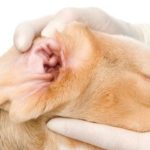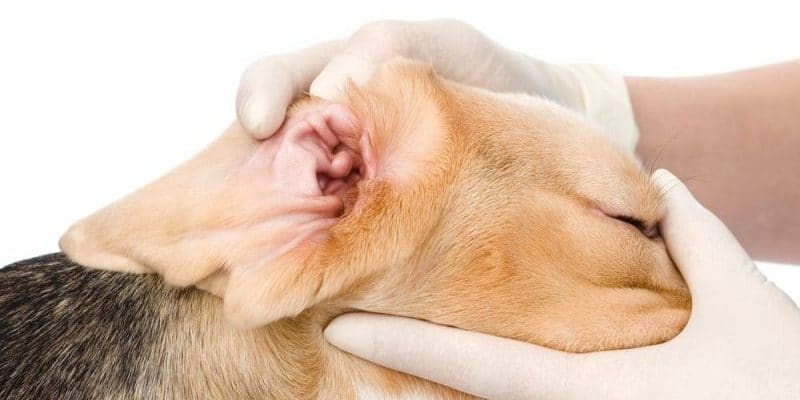The most common ear disorders in dogs are caused by infections, mites, and foreign bodies in the ear canal; some breeds are prone to deafness. See your vet promptly if your dog is showing any signs of an ear problem.
Signs of Ear Disorder
- Shaking head, yelping
- Rubbing at one ear
- Rubbing at both ears (can be sign of allergy)
- Smelly ear or ears
- Pain when ear is touched
- Pain while eating
- Deafness
- Swollen ear flap (aural hematoma)
- Head tilt, loss of balance, nausea (can be signs of middle or inner ear disease)
Aural Hematoma
Bleeding can sometimes occur inside a dog’s ear flap, causing a swelling known as an aural hematoma. This condition may
occur in a dog that constantly flicks his head about or scratches his ear. Often, the hematoma is accompanied by infection in the outer ear canal.
A vet may be able to reduce the swelling by draining the blood through a needle and injecting a corticosteroid. Some dogs can tolerate this procedure without sedation. Surgery is also an option. Left untreated, the ear flap will shrink and crinkle.
Outer Ear Problems
 If you see your dog rubbing at his ear, he may be troubled by an allergy, ear mites, or an infection. Another common problem is a sharp grass awn lodged in the outer ear canal; this is extremely painful and your dog will probably react by vigorously shaking his head and yelping.
If you see your dog rubbing at his ear, he may be troubled by an allergy, ear mites, or an infection. Another common problem is a sharp grass awn lodged in the outer ear canal; this is extremely painful and your dog will probably react by vigorously shaking his head and yelping.
To look down the full length of the outer canal to the ear drum, your vet will use a viewing instrument called an auroscope. This examination can be painful for your dog and he may have to be sedated first.
Ear mites are treated with ear drops or topical products that are applied directly to the skin on the back of the neck. Infections are initially treated with antibiotic ear drops, but if this fails, the vet will take a swab for microscopic examination and testing for drug sensitivity.
The infected ear may be flushed under general anesthetic; occasionally, surgery is necessary.
Hazard in the grass: A dog that suddenly starts pawing at an ear, shaking his head, and squealing after running outdoors is likely to have picked up a grass awn in the outer ear canal. Removal may have to be done under sedation or general anesthetic.
Binding an ear: A cut ear flap will bleed profusely from even a small nick. The wound should be treated and the ear bandaged to the head to prevent the dog from flicking it and causing fresh bleeding.
Avoid water: Try to prevent your dog from swimming if he is prone to ear infections. Exercise him away from water if the temptation to jump in is too great.
Middle and Inner Ear
Infections of the outer ear sometimes spread to the middle part of the ear. Another cause of middle ear infection is penetration of the eardrum by a foreign body.
Middle and inner ear infections can also be caused by an adverse reaction to ear drops used to treat outer ear problems. The signs of infection include pain on opening the mouth, lethargy, and discharge. Other common signs are loss of balance, head tilting, and vomiting.
In both middle and inner ear disease, early diagnosis – often with imaging such as radiography and MRI – and treatment are vital.
Deafness
Many older dogs are affected by age-related deafness and are hard to wake or fail to come when you call – but you should suspect selective deafness if your senior reacts promptly to the rattle of a food bowl.
Congenital deafness is often hereditary and possibly linked to coat color; white-coated breeds, such as the Bichon Frise and the Dalmatian, are particularly susceptible. A profoundly deaf puppy can be identified readily, since he responds to sounds differently from the rest of his litter.
Your dog’s hearing can be assessed using the Brainstem Auditory Evoked Response test (BAER) which detects electrical activity in the inner ear and aural pathways of the brain. It is painless and can be performed on puppies without distressing them, although older dogs may need sedation.
Applying Ear Drops
- Shake the bottle if the ear drops are in suspension, and gently pull back the ear flap to expose the ear canal.
- Still holding back the ear flap, squirt the recommended number of drops into the ear canal.
- Gently massage the ear to help the drops to penetrate. Afterward, give your dog plenty of praise and a treat.

